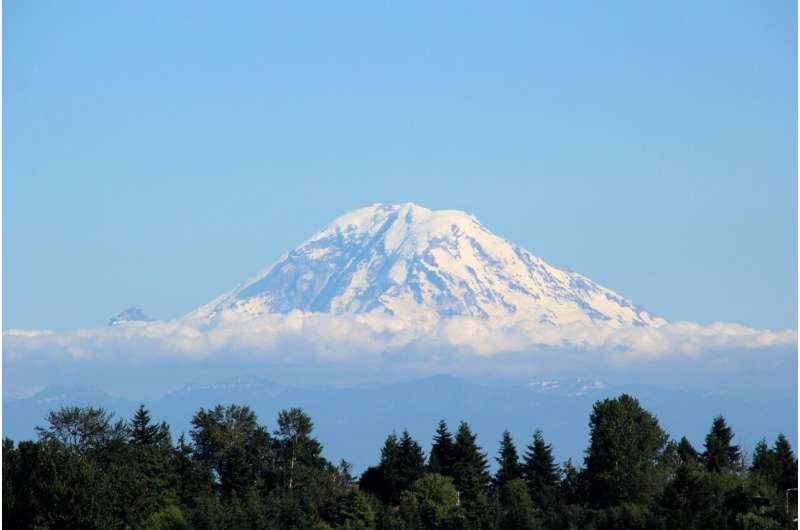This article has been reviewed according to Science X's editorial process and policies. Editors have highlighted the following attributes while ensuring the content's credibility:
fact-checked
reputable news agency
proofread
Group sues over federal protections for snow-loving bird, 'harbinger' of climate change

As climate change warms Washington's mountain ranges, environmentalists are suing the federal government to protect one snow-loving bird of the Cascades.
The Center for Biological Diversity filed a lawsuit against the U.S. Fish and Wildlife Service in federal court in Arizona on Thursday, demanding the agency provide Endangered Species Act protections for the Mount Rainier white-tailed ptarmigan, a beloved species that thrives in the fluffy snow and alpine meadows from southern British Columbia to Mount Adams.
The agency missed a deadline to complete the process of listing the ptarmigan as threatened, the lawsuit alleges. The center first petitioned for the listing in 2010.
"In part, our effort is just to highlight: We're at risk of losing this unique bird and its habitat if we don't do something to address climate change," Noah Greenwald, endangered species director for the center, said in an interview.
The Mount Rainier white-tailed ptarmigan has adapted to live in frigid climates, burrowing into dry, fluffy snow and packing on weight to keep warm in the winters.
But as snow levels rise to higher elevations and average annual snowpack declines, its habitat is shrinking.
"This bird is really a harbinger of climate change in Washington state," Greenwald said.
The total mass of glacier ice on Mount Rainier has shrunk by more than half since the late 1800s, according to new estimates. Just last year, a team of researchers discovered the loss of Hinman Glacier, once the largest glacier between Mount Rainier and Glacier Peak. The glacier previously supercharged the Skykomish River with cool water, a river that's recently seen some of the lowest runs of wild Chinook recorded.
These are likely all symptoms of higher concentrations of greenhouse gases, which are keeping nighttime temperatures high, making for warmer summers and winters, Washington state climatologist Nick Bond said.
Meanwhile, snow levels, or the elevation at which rain turns to snow in the cooler months, are ratcheting up in the Cascades, Bond said. It's harder to pin the variation in snow level on climate change.
"You might think well, species like these: The ptarmigan or the marmots or whatever it is can just go uphill where it's as cold as they like it," Bond said. "But, you kind of run out of real estate, maybe there isn't the kind of vegetation to munch on."
State researchers don't really know much about the beautiful mountain birds, said Michael Schroeder, upland bird research scientist for the state Department of Fish and Wildlife.
The white-tailed ptarmigan is the smallest bird in the grouse family, typically growing no longer than 12 inches. It transforms with the seasons, from snow white, to mottled brown or black in summer to blend with the landscape. It has heavily feathered feet that act like snowshoes in winter.
The birds are generally distributed throughout the higher elevations of the Cascades, in the zone above the tree line before the highest glaciers. They like to eat alpine vegetation through much of the year and have been known to live up to 15 years.
There have been no population estimates, but researchers know they haven't lived near Mount St. Helens since the eruption. They also know ptarmigan are especially vulnerable to climate change.
"Climate change is one of the reasons why there are concerns about ptarmigan," Schroeder said.
While the birds in the winter rely on snow, in summer, the ptarmigan prefers cool, damp areas created by melting snowfields and glaciers. According to the federal proposed rule for listing the species, rising temperatures associated with climate change are expected to have direct and rapid effects on individual ptarmigan, which experience physiological stress at 70 degrees.
After strapping a transmitter onto one of the birds, state officials found it had migrated to higher elevations in British Columbia for the winter, suggesting the ptarmigan was able to move through the Cascades with few barriers. Officials plan to survey the habitat up north, but the federal proposed rule warns it's "unlikely that Mount Rainier white-tailed ptarmigan will adapt to the changing climate by moving northward because alpine areas north of their current range are expected to undergo similar impacts due to climate change."
The alpine meadows of the Cascades used by breeding ptarmigans could decline by 95% in the next five decades under current climate-change projections, according to the center.
As the climate warms, animals like ptarmigan could be forced higher and higher up in elevation, and their islands of habitat will become smaller and farther apart, Schroeder said. Some populations might become isolated and eventually might die out if they aren't able to move through their habitat range.
The birds haven't been a big research priority for the state to date, but a federal listing could unlock funding to better understand what can be done to preserve their habitat.
2023 The Seattle Times. Distributed by Tribune Content Agency, LLC





















